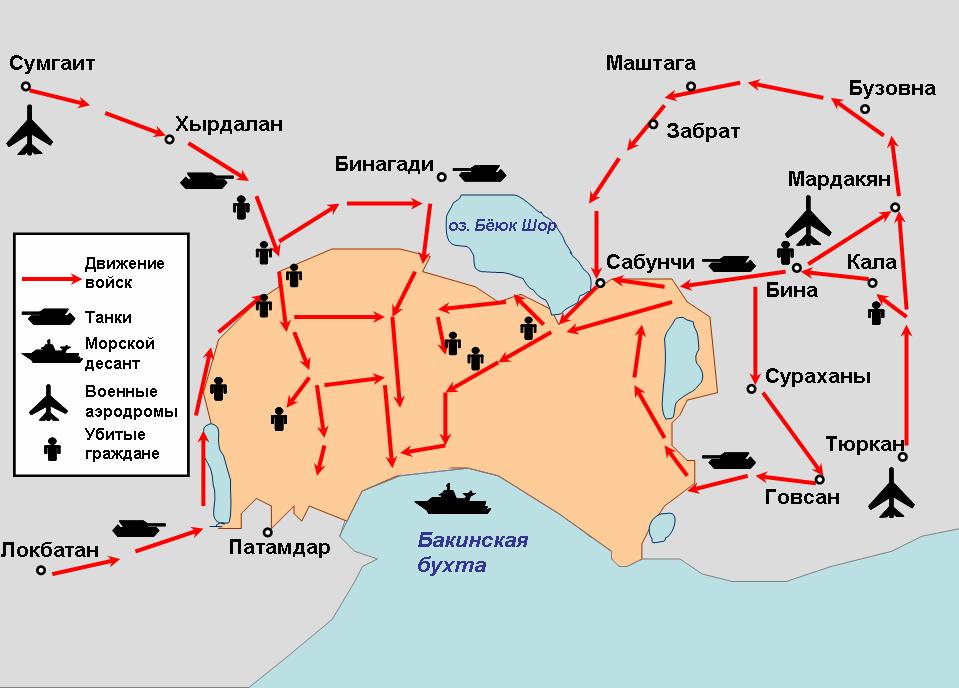
Human Rights Watch report on “Black January in Azerbaijan” stated, “Indeed, the violence used by the Soviet Army on the night of January 19-20 was so out of proportion to the resistance offered by Azerbaijanis as to constitute an exercise in collective punishment”. In fact, the tragedy of 20 January was politically motivated and was the most brutal among the military invasions by the Soviet troops to Almaty (1986), Tbilisi (1989), and Vilnius (1991).
20 January 2020 marks the 32nd anniversary of the military invasion and vicious killing of civilians in the city of Baku, Azerbaijan, by the forces of the Soviet Army on 20 January 1990. In response to the rising national independence movement, the Soviet leadership ordered some 26000 troops with heavy military equipment to storm the city of Baku in an operation called “Strike”.
The heavy-handed crackdown resulted in 147 civilian deaths and the injuring of around 800 people. The invasion was launched at midnight and was committed with particular violence against children, women and the elderly. Nevertheless, it was a heroic page in the history of Azerbaijani people’s struggle for freedom and independence. This violent suppression brought a 70-year Soviet rule in Azerbaijan to an end and led to the restoration of its national independence.
The events of 20 January were mainly provoked by the territorial claims of neighboring Armenia, requiring the annexation of the Nagorno-Karabakh Autonomous Oblast (NKAO) of Azerbaijan. On December 1, 1989 the Supreme Council of the Armenian SSR made the unprecedented decision on “reunification” of the Armenian SSR and NKAO, and thus grossly violated the Constitution of the USSR and Azerbaijan SSR. This decision had a very serious impact on further relations between the two republics inflaming a mass hatred towards each other. It also laid the ground for bloody ethnic cleansing against local Azerbaijani population in Armenia.
By January 1990 the entire Azerbaijani population living in Armenia had been forcibly expelled from the places of their permanent residence. In an effort to oust them from Armenia an estimated 300 000 Azerbaijanis were subjected to murder, torture and persecution and were forced to take refuge in Azerbaijan. These displaced Azerbaijanis - deprived of homes and shelters- were mainly settled in Baku and its suburbs.
This kind of illegal and hostile policy of Armenian authorities ignited anger among Azerbaijanis precipitating their mass protest against the ambiguous and negligent position of the USSR leadership in this regard. In 1989-1990, hundreds of thousands of people held demonstrations in the central square (now Freedom square) and the streets of Baku were protesting the Armenia’s separatist claims to tear out the Nagorno-Karabakh region from Azerbaijan and annexing it to Armenia.
The Secretary General of the Communist Party of the USSR, Michael Gorbachev to suppress the peaceful demonstrations in Baku sent to Baku the military contingent of Soviet Army and Interior troops. As it was later stated by D.Yazov, Minister of Defense of the USSR, the use of force in Baku was intended to prevent the takeover of the power in Azerbaijan by non-Communist opposition and ensure that the Communist government remained in power.
On the eve of the assault the special forces of the Soviet Army attacked the state TV building in Baku, cutting off the national TV and radio broadcast to prevent the dissemination of news to the local and international community. Therefore, the people were deprived of access to information about the entry of the Soviet troops into the city. Advance warning might have cleared the streets of peaceful civilians and saved their lives. In fact, instructing the army to use force against civilian citizens cannot be justified under any circumstances.
Incited with hatred against the local population and under the influence of alcohol and narcotic drugs, the Soviet soldiers indiscriminately fired on women, elderly and infants; even drivers of the ambulance cars and doctors were subjected to brutal killing. Tanks and armored transporters were crushing civilian and medical vehicles with people inside. Electricity of the hospitals had been cut off to prevent medical aid to the wounded.
Human Rights Watch report on “Black January in Azerbaijan” stated, “Indeed, the violence used by the Soviet Army on the night of January 19-20 was so out of proportion to the resistance offered by Azerbaijanis as to constitute an exercise in collective punishment”. In fact, the tragedy of 20 January was politically motivated and was the most brutal among the military invasions by the Soviet troops to Almaty (1986), Tbilisi (1989), and Vilnius (1991).
Even though Azerbaijani people suffered great losses from the tragedy of 20 January 1990, its pride and dignity remained untainted. Black January was a turning point in the history of Azerbaijan and proved to be a vivid manifestation of the bravery and determination of its people in restoring their national independence.
Source: Embassy of Azerbaijan in Bulgaria